A Phase Field Study of the Influence of External Loading on the Dynamics of Martensitic Phase Transformation
Abstract
1. Introduction
2. The Elastoplastic Phase Field Model
3. Simulation Parameters and Conditions
4. Simulation Results and Analysis
4.1. Martensitic Phase Transformation without External Loading
4.2. Microstructure Evolution of Martensitic Phase Transformation under External Loading
4.3. Dynamics Analysis of Martensitic Phase Transformation under External Loading and Plastic Deformation
4.4. Prediction of Ms Temperature and TRIP Effect
5. Conclusions
- (1)
- In the martensitic phase transformation process under external loading conditions, uniaxial tensile loading increases the martensitic phase transformation start temperature Ms and promotes martensitic phase transformation. On the other hand, uniaxial compressive loading, while not significantly lowering Ms, accelerates the transformation of austenite to martensite, resulting in an increase in martensite volume fraction and faster phase transformation kinetics. The acceleration effect of uniaxial compressive loading is superior to that of uniaxial tensile loading. Triaxial compressive loading reduces the Ms temperature and inhibits the martensitic phase transformation. This conclusion aligns with relevant experimental findings.
- (2)
- The implementation of a phase-field model was employed to simulate martensitic phase transformation under the influence of both plastic accommodations and stress accommodations. The simulation results revealed that, in the presence of external loading conditions, the impact of external loading on martensite volume fraction outweighed the influence of plastic effects. Furthermore, external loading and plastic deformation can release the elastic strain energy during the martensitic phase transformation process.
- (3)
- Simulations of microstructure evolution during the martensitic phase transformation in Fe-Ni alloys were performed. The simulation results vividly demonstrate that different variants are favored to transform under corresponding stress conditions. Under uniaxial tensile loading, the growth of martensite variants 2 and 3 is promoted. Under uniaxial compressive loading, martensite variant 1 is favored to grow. Under triaxial compressive loading, the growth of all three martensite variants is inhibited.
Author Contributions
Funding
Institutional Review Board Statement
Informed Consent Statement
Data Availability Statement
Conflicts of Interest
References
- Mohapatra, S.; Poojari, G.; Marandi, L.; Das, S.; Das, K. A systematic study on microstructure evolution, mechanical stability and the micro-mechanical response of tensile deformed medium manganese steel through interrupted tensile test. Mater. Charact. 2023, 195, 112562. [Google Scholar] [CrossRef]
- Hao, S.; Chen, L.; Wang, Y.; Zhang, W.; She, J.; Jin, M. Influence of loading direction on tensile deformation behavior of a lean duplex stainless steel sheet: The role of martensitic transformation. Mater. Sci. Eng. A 2022, 848, 143384. [Google Scholar] [CrossRef]
- Wang, P.; Zheng, W.; Yu, X.; Wang, Y. Advantageous Implications of Reversed Austenite for the Tensile Properties of Super 13Cr Martensitic Stainless Steel. Materials 2022, 15, 7697. [Google Scholar] [CrossRef] [PubMed]
- Kakeshita, T.; Fukuda, T.; Saburi, T. Time-dependent nature of the athermal martensitic transformations in Fe-Ni-alloys. Scr. Mater. 1996, 34, 147–150. [Google Scholar] [CrossRef]
- Kavousi, S.; Ankudinov, V.; Galenko, P.K.; Zaeem, M. Atomistic-informed kinetic phase-field modeling of non-equilibrium crystal growth during rapid solidification. Acta Mater. 2023, 253, 118960. [Google Scholar] [CrossRef]
- Lv, S.; Wang, S.; Wu, G.; Gao, J.; Yang, X.; Wu, H.; Mao, X. Application of phase-field modeling in solid-state phase transformation of steels. J. Iron Steel Res. Int. 2022, 29, 867–880. [Google Scholar] [CrossRef]
- Tourret, D.; Liu, H.; Llorca, J. Phase-field modeling of microstructure evolution: Recent applications, perspectives and challenges. Prog. Mater. Sci. 2022, 123, 100810. [Google Scholar]
- Qin, R.S.; Bhadeshia, H.K. Phase field method. Mater. Sci. Technol. 2010, 26, 803–811. [Google Scholar] [CrossRef]
- Wang, Y.; Khachaturyan, A.G. Three-dimensional field model and computer modeling of martensitic transformations. Acta Mater. 1997, 45, 759–773. [Google Scholar] [CrossRef]
- Artemev, A.; Wang, Y.; Khachaturyan, A.G. Three-dimensional phase field model and simulation of martensitic transformation in multilayer systems under applied stresses. Acta Mater. 2000, 48, 2503–2518. [Google Scholar] [CrossRef]
- Yamanaka, A.; McReynolds, K.; Voorhees, P.W. Phase field crystal simulation of grain boundary motion, grain rotation and dislocation reactions in a BCC bicrystal. Acta Mater. 2017, 133, 160–171. [Google Scholar] [CrossRef]
- Yeddu, H.K.; Borgenstam, A.; Ågren, J. Stress-assisted martensitic transformations in steels: A 3-D phase-field study. Acta Mater. 2013, 61, 2595–2606. [Google Scholar] [CrossRef]
- Li, Y.; Guan, Q.; He, B. Improving the strength and ductility of medium Mn steel by depleting the stress-assisted martensite. Scr. Mater. 2023, 226, 115267. [Google Scholar] [CrossRef]
- Tian, Y.; Borgenstam, A.; Hedström, P. Comparing the deformation-induced martensitic transformation with the athermal martensitic transformation in Fe-Cr-Ni alloys. J. Alloys Compd. 2018, 766, 131–139. [Google Scholar] [CrossRef]
- Patel, J.R.; Cohen, M. Criterion for the action of applied stress in the martensitic transformation. Acta Metall. 1953, 1, 531–538. [Google Scholar] [CrossRef]
- Hagiwara, I.; Kanazawa, S. Effect of Applied Stress Upon the Martensite Transformation. J. Jpn. Inst. Met. Mater. 1961, 25, 213–216. [Google Scholar] [CrossRef][Green Version]
- Chen, L.; Shen, J. Applications of semi-implicit Fourier-spectral method to phase field equations. Comput. Phys. Commun. 1998, 108, 147–158. [Google Scholar] [CrossRef]
- Cui, S.; Lei, Z.; Tao, F. Phase-Field Simulation of Thermoelastic Martensitic Transformation in U-Nb Shape Memory Alloys. Rare Metal Mat. Eng. 2022, 51, 452–460. [Google Scholar]
- Heo, T.W.; Chen, L. Phase-field modeling of displacive phase transformations in elastically anisotropic and inhomogeneous polycrystals. Acta Mater. 2014, 76, 68–81. [Google Scholar] [CrossRef]
- Ohmer, D.; Yi, M.; Gutfleisch, O.; Xu, B. Phase-field modelling of paramagnetic austenite–ferromagnetic martensite transformation coupled with mechanics and micromagnetics. Int. J. Solids Struct. 2022, 238, 111365. [Google Scholar] [CrossRef]
- Mamivand, M.; Zaeem, M.A.; El Kadiri, H. Effect of variant strain accommodation on the three-dimensional microstructure formation during martensitic transformation: Application to zirconia. Acta Mater. 2015, 87, 45–55. [Google Scholar] [CrossRef]
- Gao, Y.; Zhou, N.; Wang, D.; Wang, Y. Pattern formation during cubic to orthorhombic martensitic transformations in shape memory alloys. Acta Mater. 2014, 68, 93–105. [Google Scholar] [CrossRef]
- Zhang, X.; Shen, G.; Xu, J.; Gu, J. Analysis of Martensitic Transformation Plasticity Under Various Loadings in a Low-Carbon Steel: An Elastoplastic Phase Field Study. Metall. Mater. Trans. A 2020, 51, 4853–4867. [Google Scholar] [CrossRef]
- Shibata, A.; Murakami, T.; Morito, S.; Furuhara, T.; Maki, T. The origin of midrib in lenticular martensite. Mater Trans. 2008, 49, 1242–1248. [Google Scholar] [CrossRef]
- Liu, H.; Lin, F.X.; Zhao, P.; Moelans, N.; Wang, Y.; Nie, J.F. Formation and autocatalytic nucleation of co-zone {101¯ 2} deformation twins in polycrystalline Mg: A phase field simulation study. Acta Mater. 2018, 153, 86–107. [Google Scholar] [CrossRef]
- Kubler, R.F.; Berveiller, S.; Bouscaud, D.; Guiheux, R.; Patoor, E.; Puydt, Q. Shot peening of TRIP780 steel: Experimental analysis and numerical simulation. J. Mater. Process. Technol. 2019, 270, 182–194. [Google Scholar] [CrossRef]
- Cluff, S.; Knezevic, M.; Miles, M.P.; Fullwood, D.T.; Mishra, R.K.; Sachdev, A.K.; Brown, T.; Homer, E.R. Coupling kinetic Monte Carlo and finite element methods to model the strain path sensitivity of the isothermal stress-assisted martensite nucleation in TRIP-assisted steels. Mech. Mater. 2021, 154, 103707. [Google Scholar] [CrossRef]
- Yeddu, H.K.; Lookman, T. Phase-field modeling of the beta to omega phase transformation in Zr–Nb alloys. Mater. Sci. Eng. A 2015, 634, 46–54. [Google Scholar] [CrossRef]
- Kakeshita, T.; Shimizu, K.; Akahama, Y.; Endo, S.; Fujita, F. Effect of Hydrostatic Pressure on Martensitic Transformations in Fe–Ni and Fe–Ni–C Alloys. Trans. JIM 1988, 29, 109–115. [Google Scholar] [CrossRef]
- Song, S.J.; Liu, F.; Zhang, Z.H. Analysis of elastic–plastic accommodation due to volume misfit upon solid-state phase transformation. Acta Mater. 2014, 64, 266–281. [Google Scholar] [CrossRef]
- Matsuoka, Y.; Iwasaki, T.; Nakada, N.; Tsuchiyama, T.; Takaki, S. Effect of grain size on thermal and mechanical stability of austenite in metastable austenitic stainless steel. ISIJ Int. 2013, 53, 1224–1230. [Google Scholar] [CrossRef]
- Kakeshita, T.; Saburi, T.; Kindo, K.; Endo, S. Effect of magnetic field and hydrostatic pressure on martensitic transformation and its kinetics. Jpn. J. Appl. Phys. 1997, 36, 7083. [Google Scholar] [CrossRef]
- Soleimani, M.; Kalhor, A.; Mirzadeh, H. Transformation-induced plasticity (TRIP) in advanced steels: A review. Mater. Sci. Eng. A 2020, 795, 140023. [Google Scholar] [CrossRef]
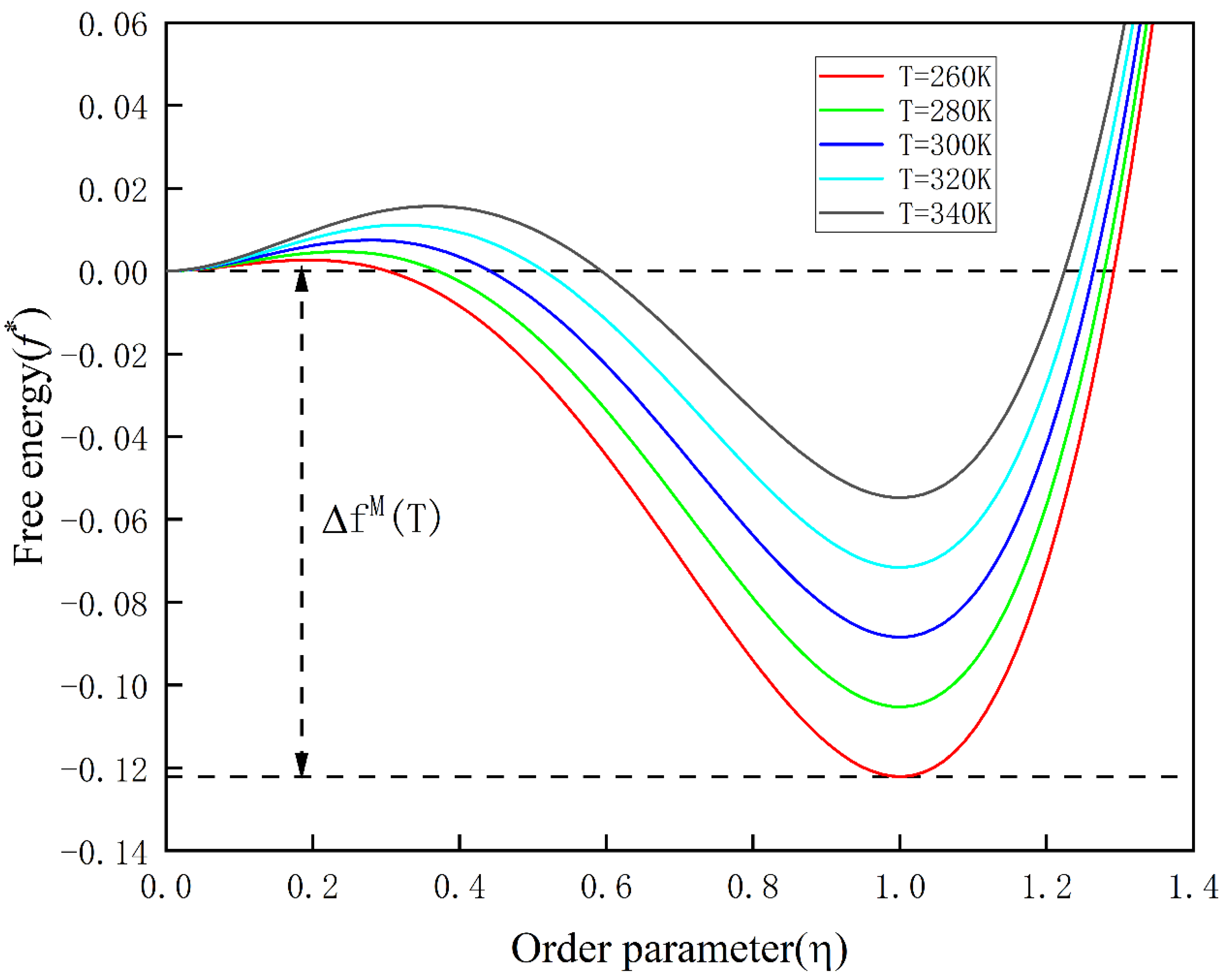
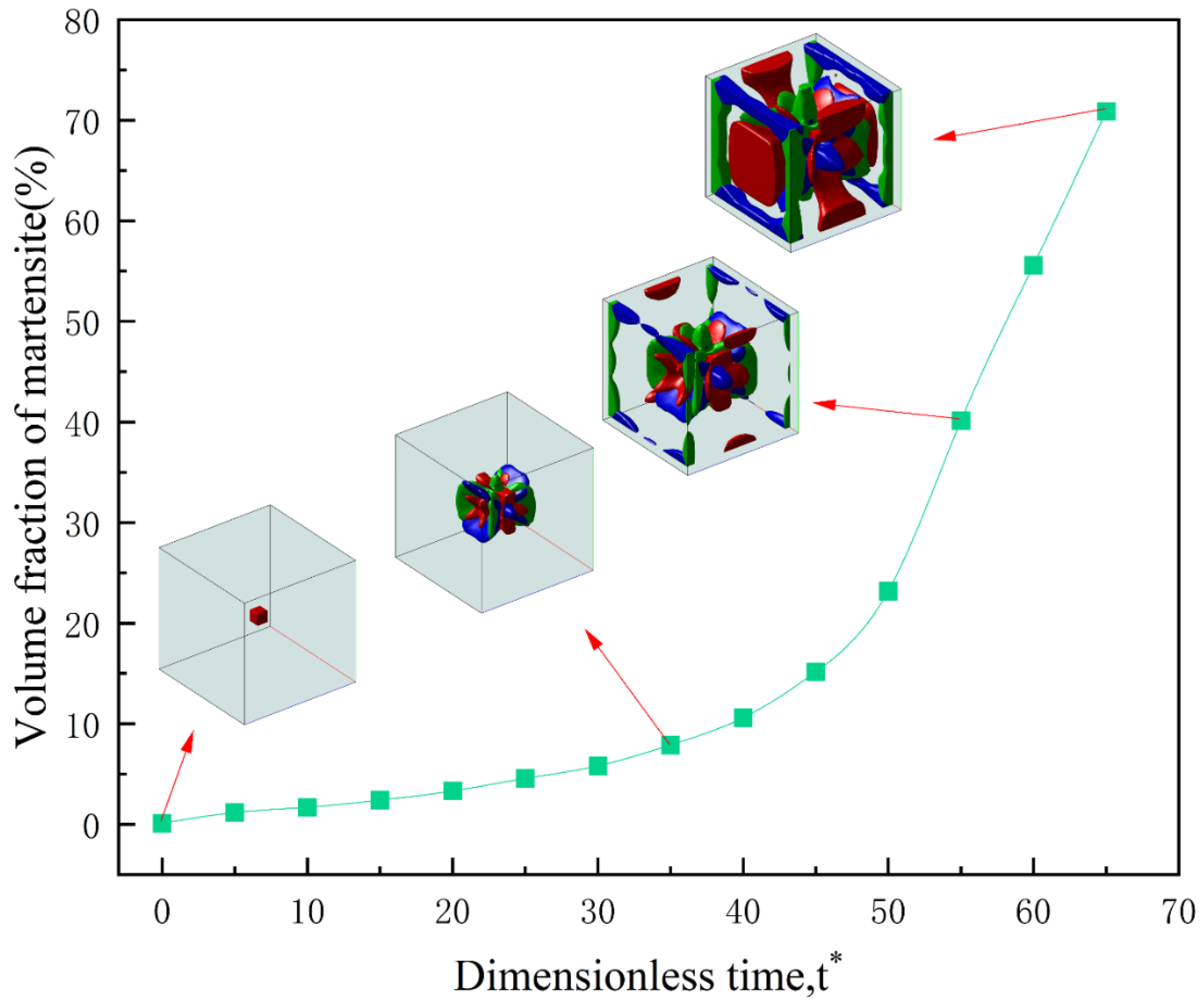
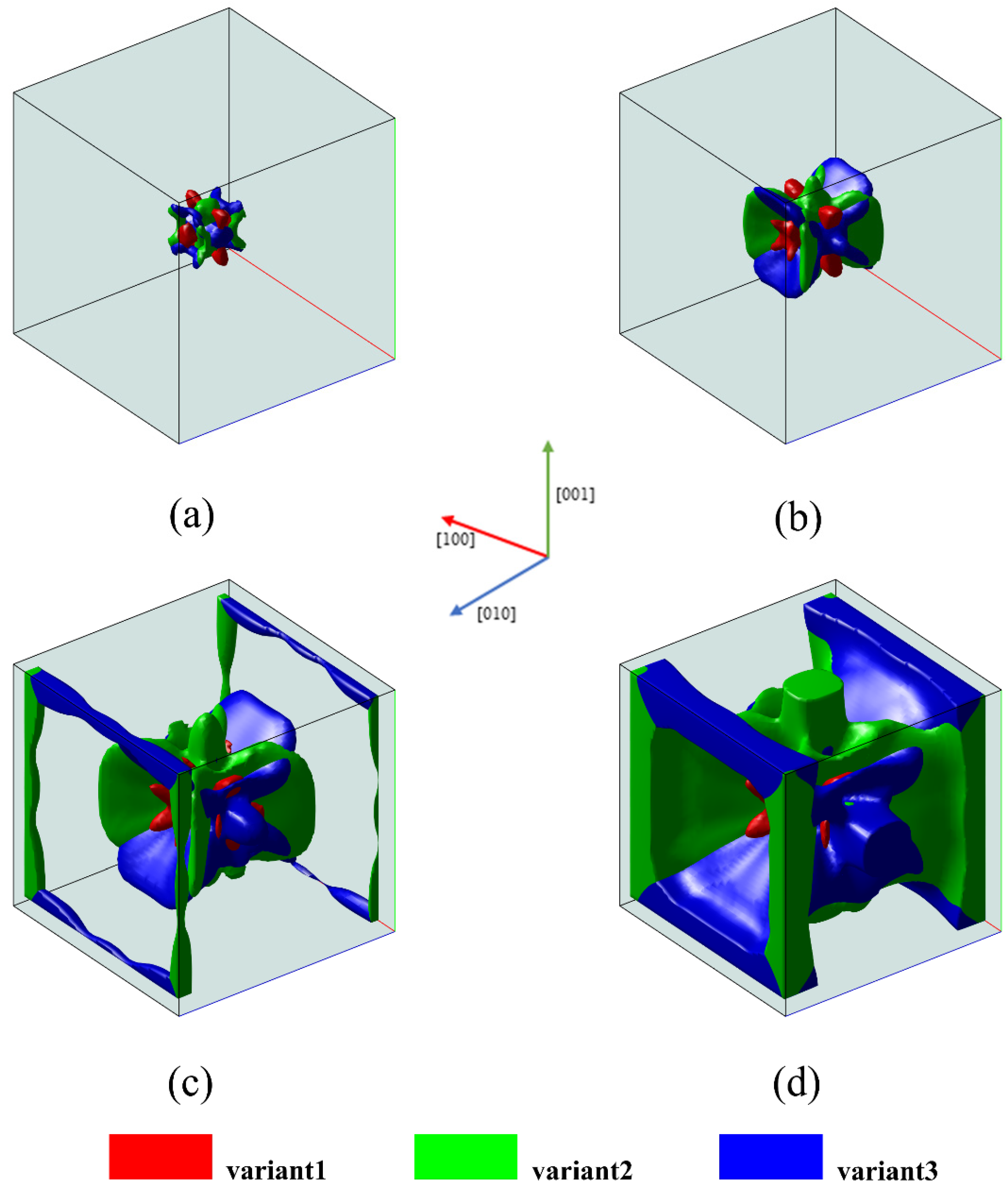
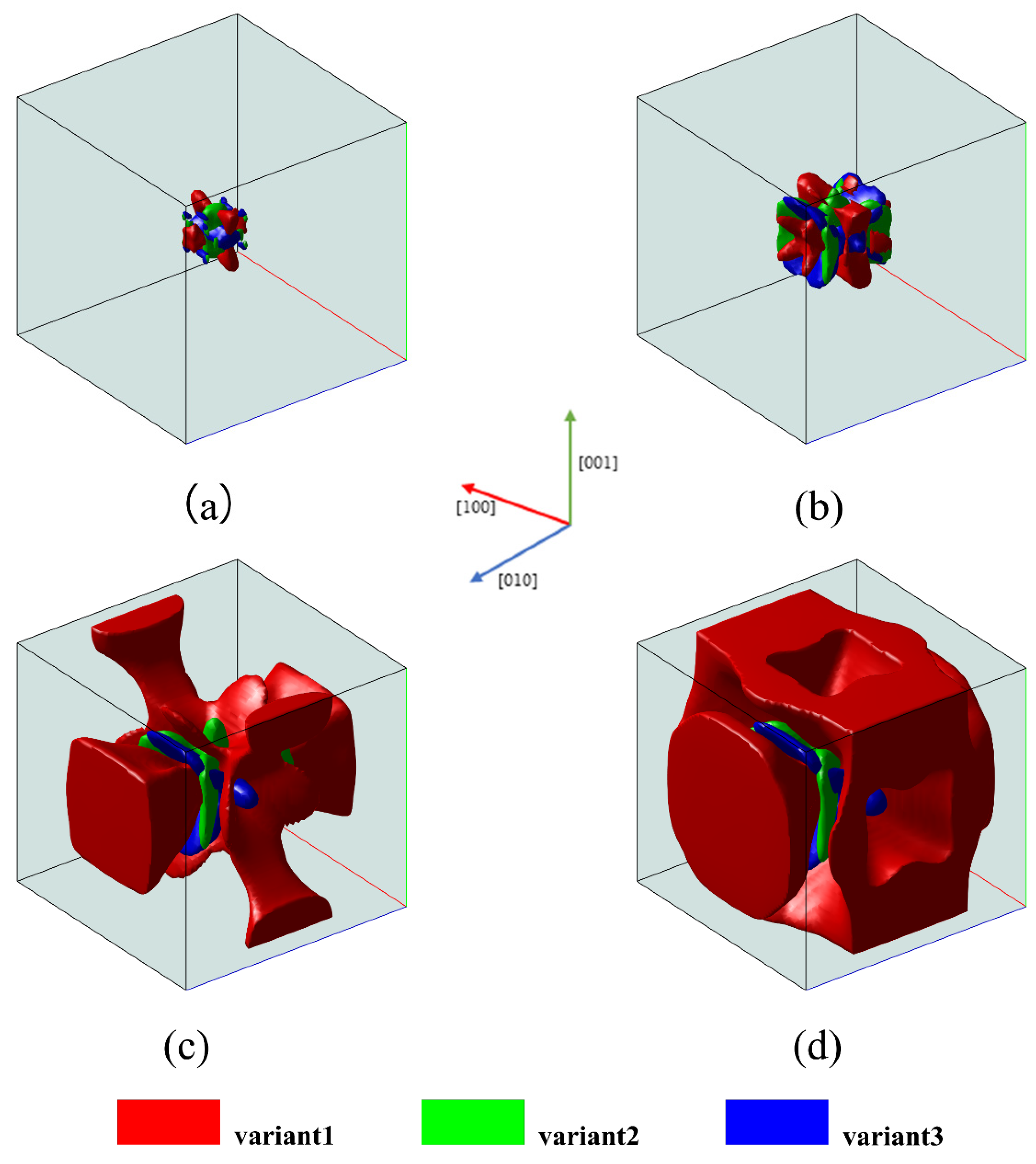
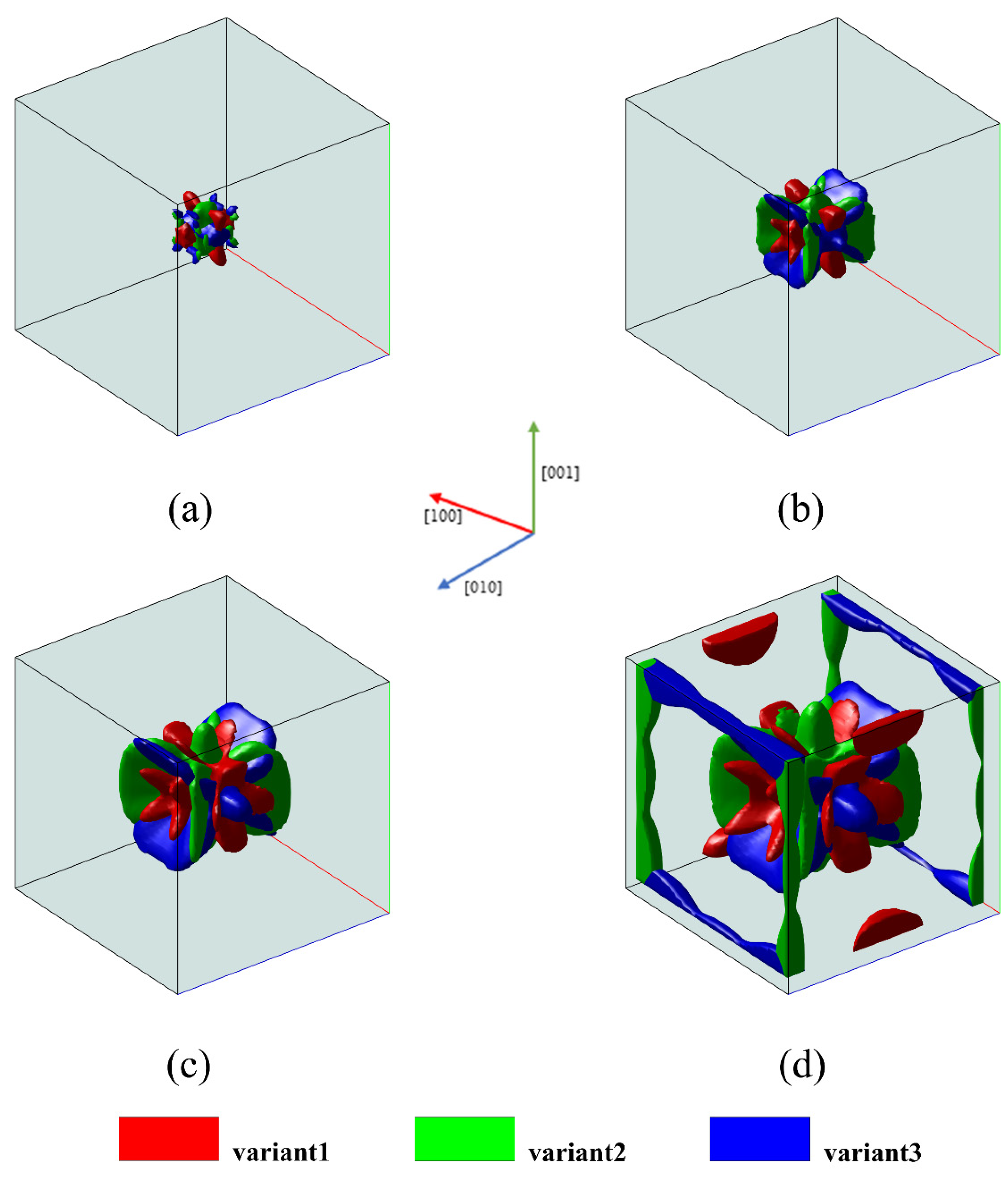

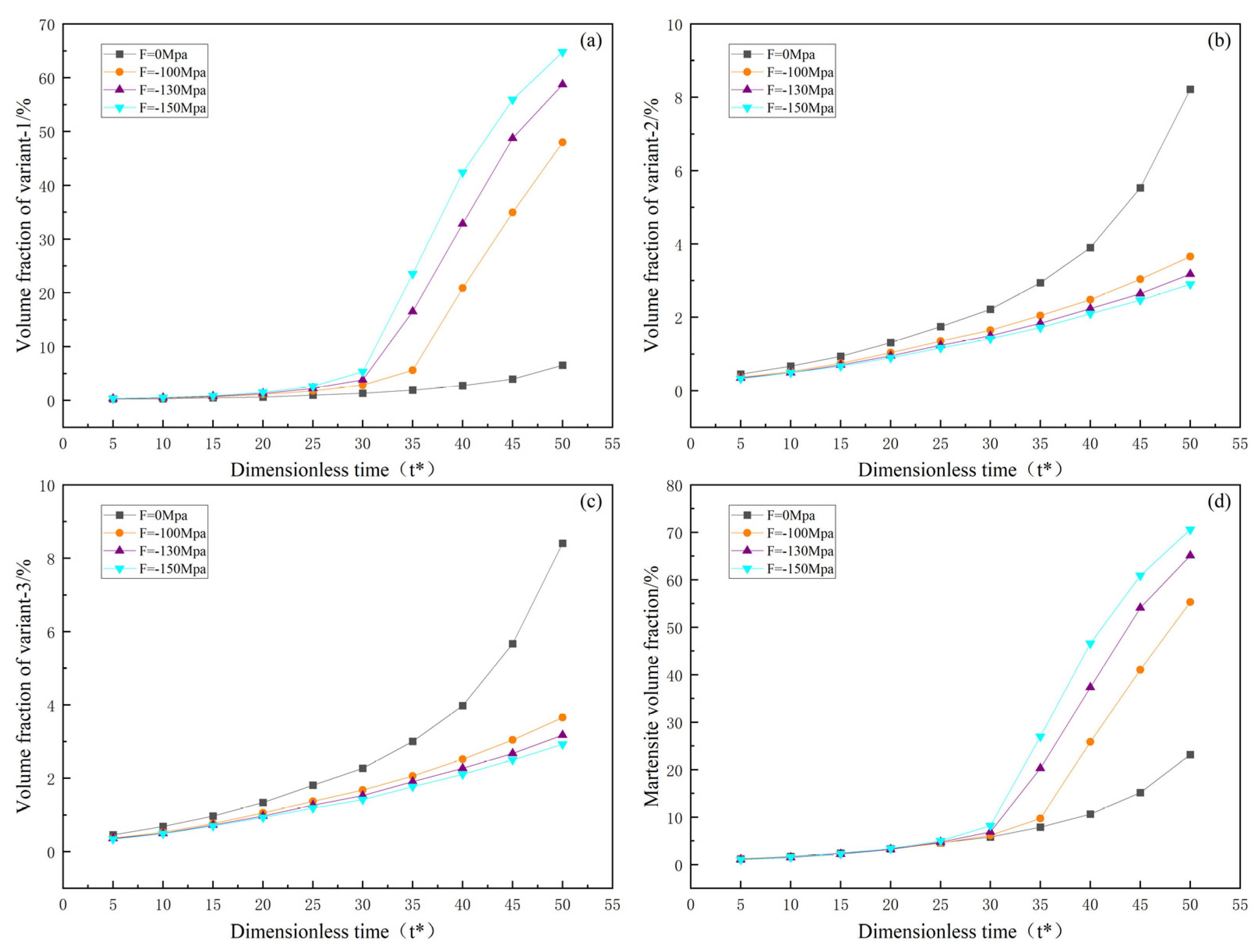
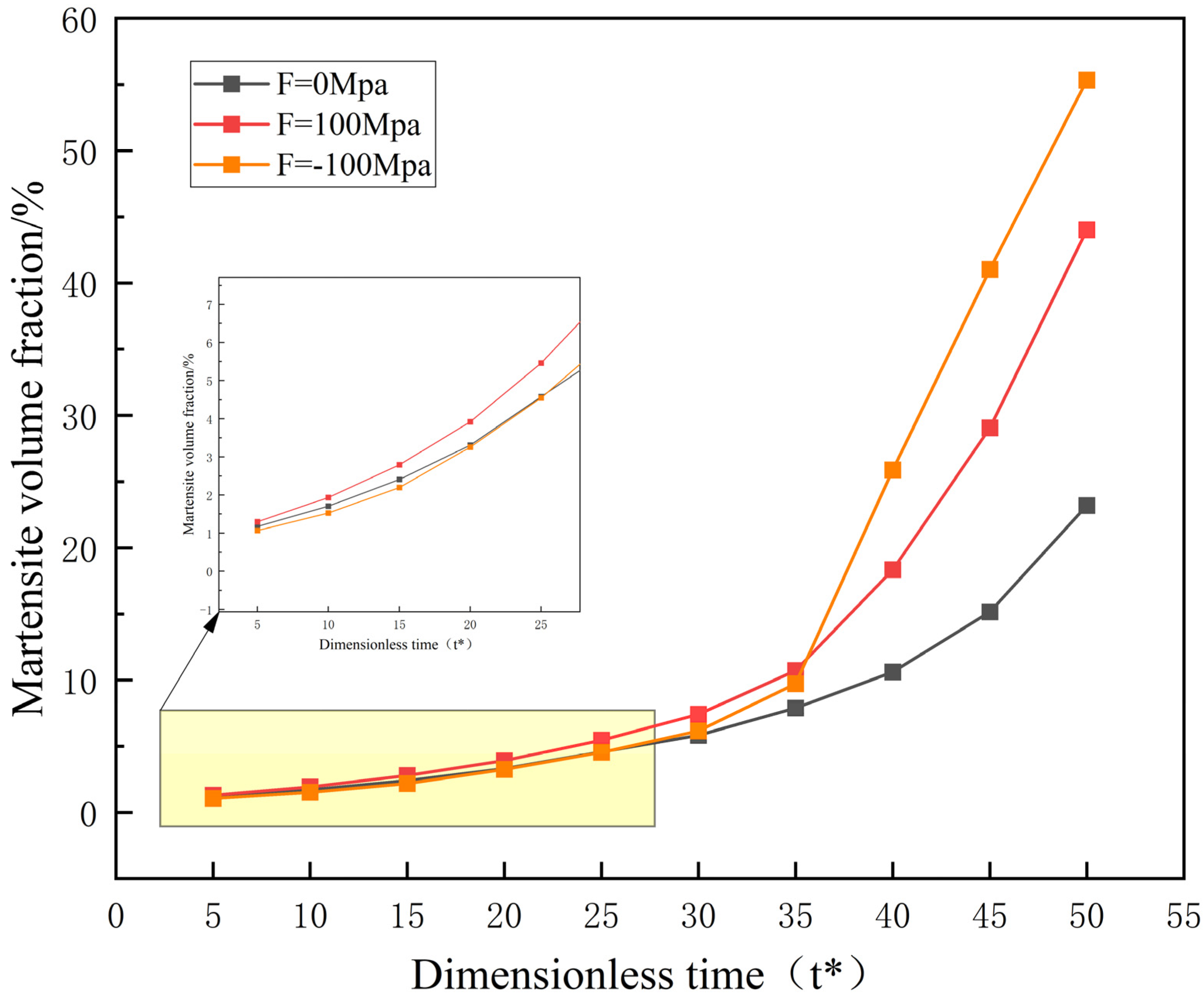

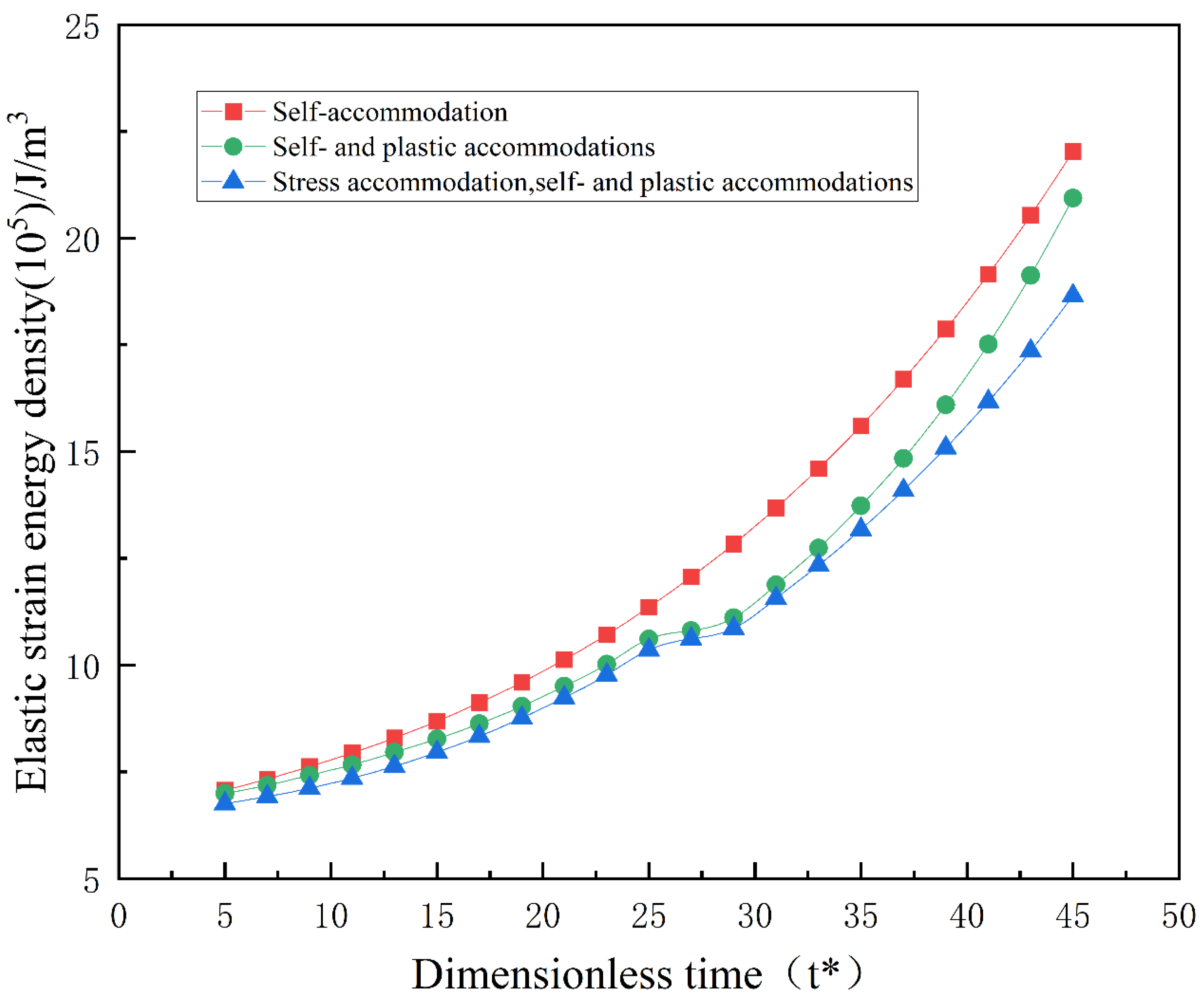

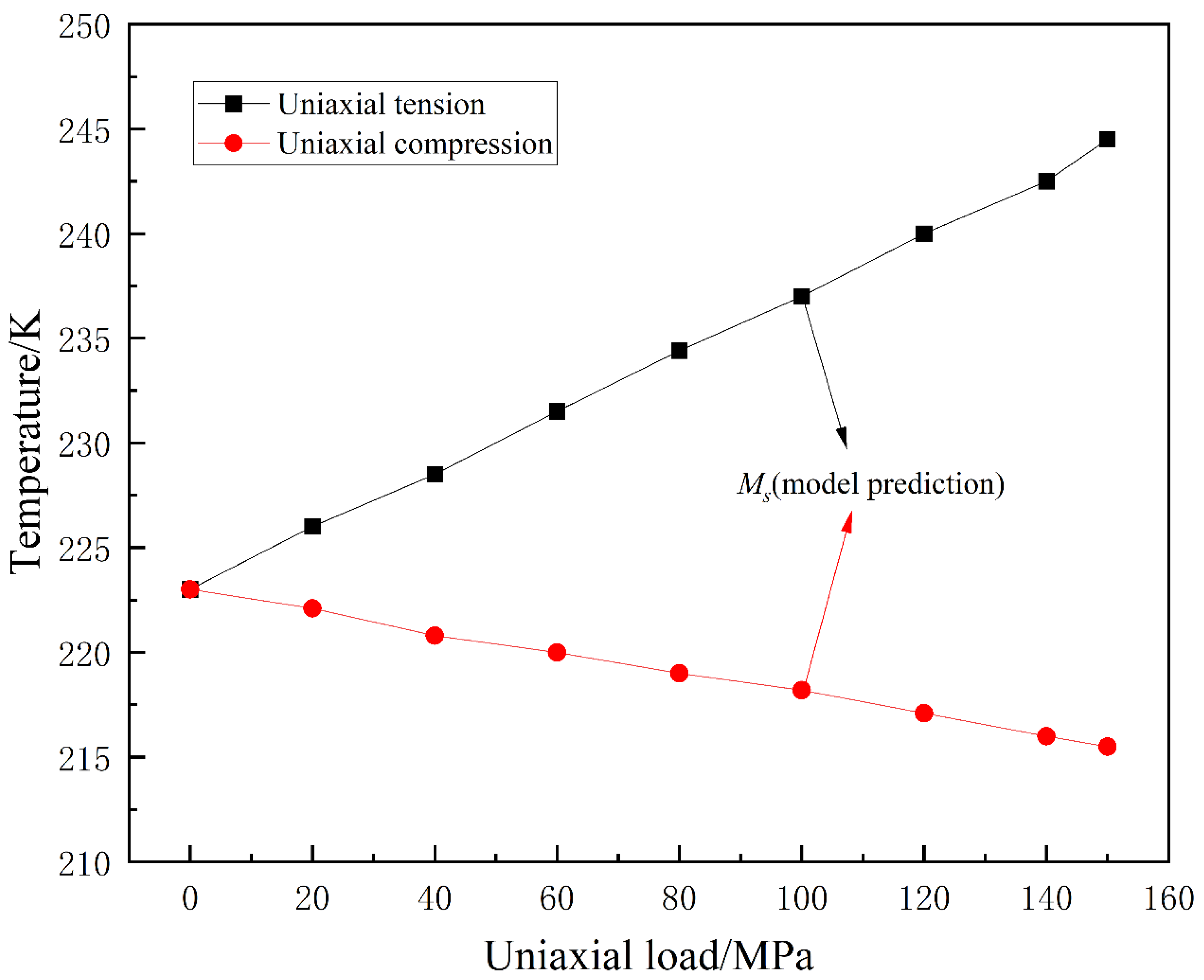
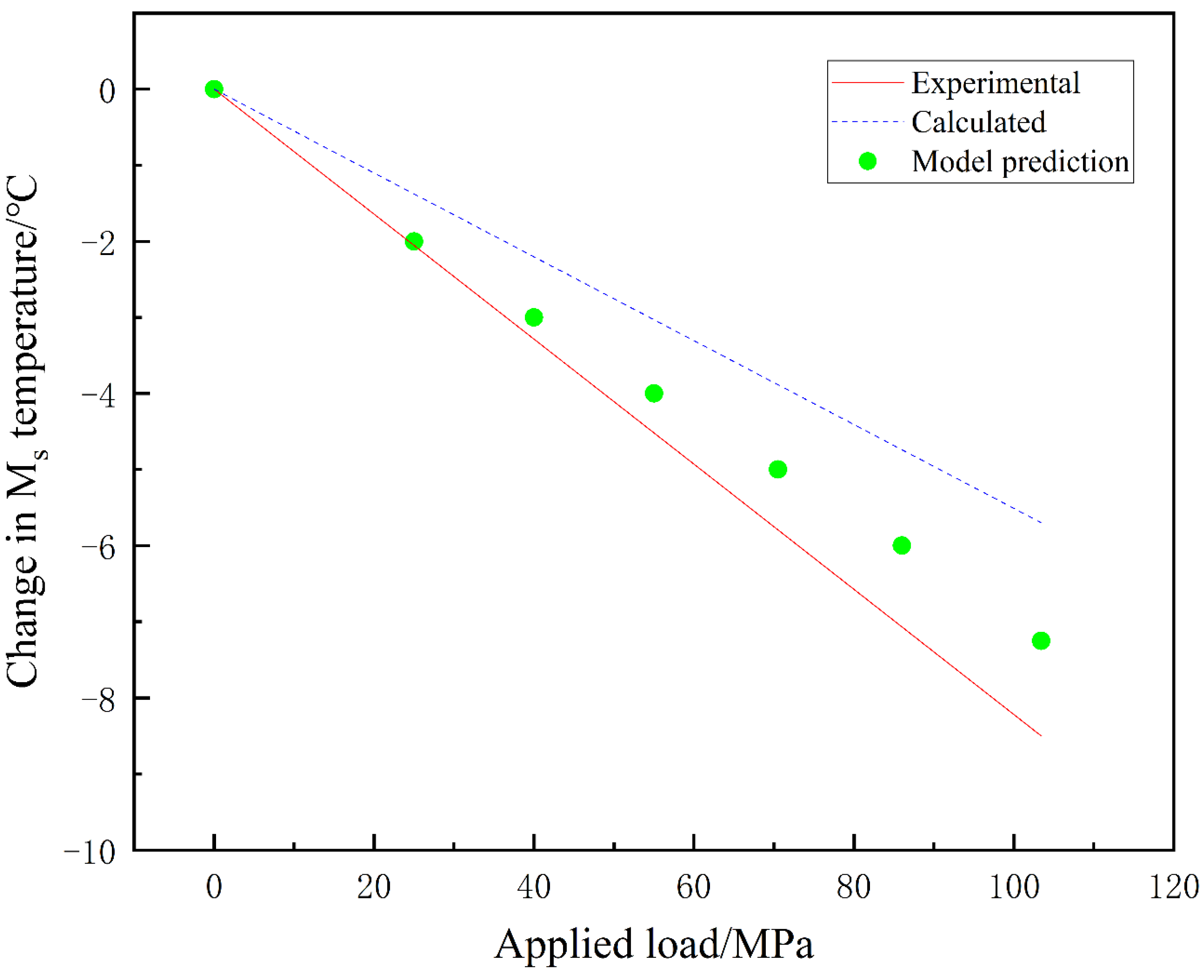
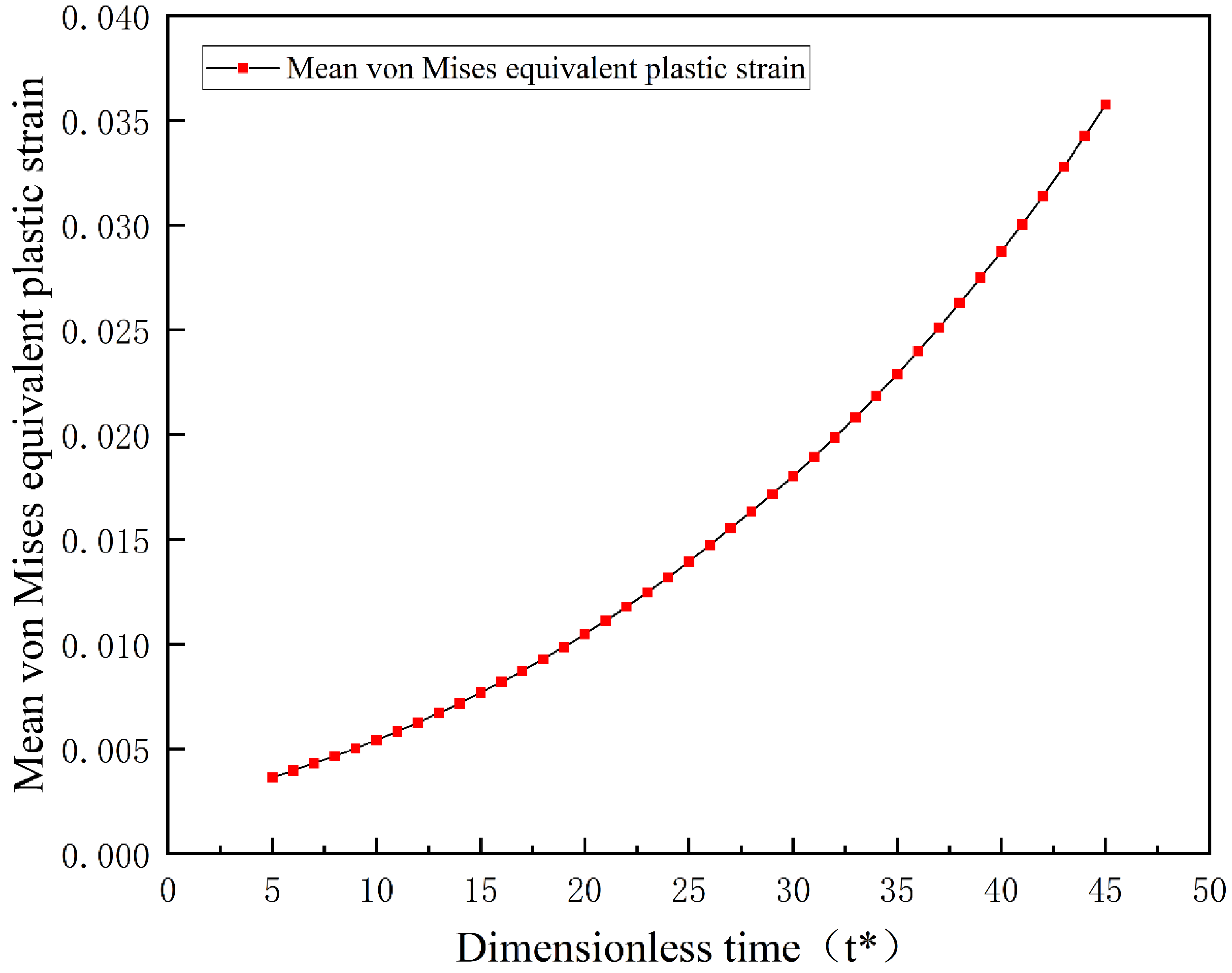
| Physical Parameter | Notation | Numerical Value |
|---|---|---|
| Latent heat for the transformation | Q/(J·m−3) | 3.5 × 108 |
| Stress-free equilibrium temperature | T0/(K) | 405 |
| Shear modulus | G/(Pa) | 2.8 × 1010 |
| Martensite start temperature | Ms/(K) | 223 |
| Characteristic energy | E0/(J·m−3) | 1.026 × 107 |
| Poisson’s ratio | v | 0.375 |
| Bain strain tensors 1 | 0.1322 | |
| Bain strain tensors 2 | −0.1994 |
| Dimensionless Parameter | Numerical Value |
|---|---|
| 60.02 | |
| 34.11 | |
| ∆x* = ∆y* = ∆z* | 1.0 |
| ∆t* | 0.01 |
Disclaimer/Publisher’s Note: The statements, opinions and data contained in all publications are solely those of the individual author(s) and contributor(s) and not of MDPI and/or the editor(s). MDPI and/or the editor(s) disclaim responsibility for any injury to people or property resulting from any ideas, methods, instructions or products referred to in the content. |
© 2023 by the authors. Licensee MDPI, Basel, Switzerland. This article is an open access article distributed under the terms and conditions of the Creative Commons Attribution (CC BY) license (https://creativecommons.org/licenses/by/4.0/).
Share and Cite
Liu, G.; Man, J.; Yang, B.; Wang, Q.; Wang, J. A Phase Field Study of the Influence of External Loading on the Dynamics of Martensitic Phase Transformation. Materials 2023, 16, 6849. https://doi.org/10.3390/ma16216849
Liu G, Man J, Yang B, Wang Q, Wang J. A Phase Field Study of the Influence of External Loading on the Dynamics of Martensitic Phase Transformation. Materials. 2023; 16(21):6849. https://doi.org/10.3390/ma16216849
Chicago/Turabian StyleLiu, Genggen, Jiao Man, Bin Yang, Qingtian Wang, and Juncheng Wang. 2023. "A Phase Field Study of the Influence of External Loading on the Dynamics of Martensitic Phase Transformation" Materials 16, no. 21: 6849. https://doi.org/10.3390/ma16216849
APA StyleLiu, G., Man, J., Yang, B., Wang, Q., & Wang, J. (2023). A Phase Field Study of the Influence of External Loading on the Dynamics of Martensitic Phase Transformation. Materials, 16(21), 6849. https://doi.org/10.3390/ma16216849






